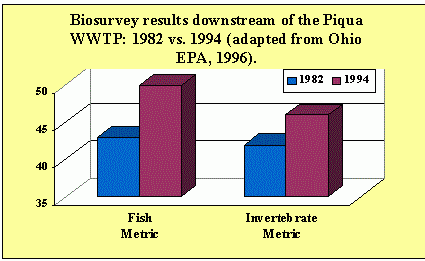Support for Permit Limits in Ohio
Program Overview
The Ohio Environmental Protection Agency uses a five-year basin approach for monitoring and NPDES reissuance. An assessment of a permitted point source's impacts on the receiving water includes an evaluation of chemical/physical data (water column, effluent, sediment, flows); biological data (fish and macroinvertebrate assemblages); and habitat data. For each permitted facility, the Ohio EPA prepares a Water Quality Permit Support Document that addresses the following topics: assessment of water quality conditions and biological status of the receiving water; wasteload allocation inputs and results; and conclusions and recommendations, with effluent limits appropriate for maintaining and restoring designated uses. The biosurveys conducted pursuant to the state's biocriteria program are an integral part of the assessment process and provide important information for setting permit limits.
The Effectiveness of Upgrades at the Piqua Waste Water Treatment Plant

The Piqua Wastewater Treatment Plant (WWTP) is located on the Great Miami River, north of the Dayton metropolitan area. Upgraded several times since its construction in 1957, the Piqua WWTP is a 4.5 MGD secondary treatment plant, which, in 1994, contributed approximately 13% of the total wastewater volume discharged by five major WWTPs to the upper Great Miami River mainstem. In 1996, the Ohio EPA generated a Water Quality Permit Support Document for the Piqua WWTP. The information assembled included the results of chemical analyses and whole effluent toxicity tests conducted by the permittee, as well as the state, during the period from about 1990 - 1995. In addition, the Ohio EPA had conducted biological sampling and ambient water chemistry sampling of the Great Miami River in 1994. All data were compared to prior information; for the biosurvey data, the previous sampling had occurred in 1982.
Acute bioassays indicated no significant adverse effects of the effluent to either invertebrates or fish, with the exception of one test (out of 11 conducted by the permittee during a three-year period). The incidence of DELT anomalies (deformities, eroded fins, lesions, tumors) on fish was very low, indicating no chronic effects of toxics. Ambient water chemistry sampling revealed no indications of serious problems with parameters commonly associated with WWTPs. Dissolved oxygen concentrations were maintained at levels well above those compatible with exceptional aquatic communities. The biological sampling results represented a remarkable improvement over those obtained in 1982 (see figure). These changes rank among the most significant improvements observed for any Ohio stream or river during the 17-year prior history of the state's biological and water quality monitoring program. Even more remarkable is the fact that, in 1982, the system was already in the "good" to "very good" range of biological performance.
The explanation for these results lies in an examination of the trends in the chemical quality of the Piqua effluent. As a result of a major upgrade at the WWTP in 1988, ammonia-nitrogen loadings dramatically declined, from median values exceeding 150-250 kg/day before the upgrade to less than 10-20 kg/day afterwards. Total phosphorus, nitrate-nitrogen, nitrite-nitrogen, total suspended solids, and oxygen demand were also reduced. Due to the exceptional quality of the biological community, the Water Quality Permit Support Document concluded that changing the current permit limits. Even during the much higher ammonia-nitrogen loadings observed prior to the 1988 upgrade, biological performance had been in the "good" to "very good" range. With the upgrade, the reduced loadings moved the biological performance into the "exceptional" range. Any adverse effects of the discharge were restricted to the mixing zone. Aquatic life use attainment status was "Full" for the recommended use designation at all sites upstream and downstream from the Piqua WWTP.
The biosurvey data were extremely valuable in demonstrating that the considerable investment made at the Piqua WWTP in 1988 resulted in meaningful and measurable improvements to the environmental conditions in the upper Great Miami River. The predominance of high quality habitats in the river allowed for the development of exceptional biological performance, once the water quality problems were abated. Thus, the continued conservation of riparian and instream habitat is a high priority in maintaining the exceptional quality of the upper Greater Miami River.
Lesson Learned
The improvement to "exceptional" in the condition of the fish and macroinvertebrate communities downstream of the Piqua WWTP was sufficient evidence that the existing permit limits for the discharge were adequately protective. Maintaining these conditions can be accomplished by habitat conservation without further WWTP controls.
Additional Information
For more information, visit the Ohio EPA website or contact Chris Yoder ([email protected]) at 614-728-3382.
References
Ohio Environmental Protection Agency. 1996a. Water Quality Permit Support Document for Piqua WWTP (1PD00008), prepared by Monitoring and Assessment Section, Division of Surface Water Quality.
Ohio Environmental Protection Agency. 1996b. Biological and Water Quality Study of the Upper Great Miami River and Selected Tributaries, Montgomery, Miami, Shelby, Logan, Clark, Hardin, and Auglaize Counties, Ohio, Ohio EPA Technical Report MAS/1995-12-13.
